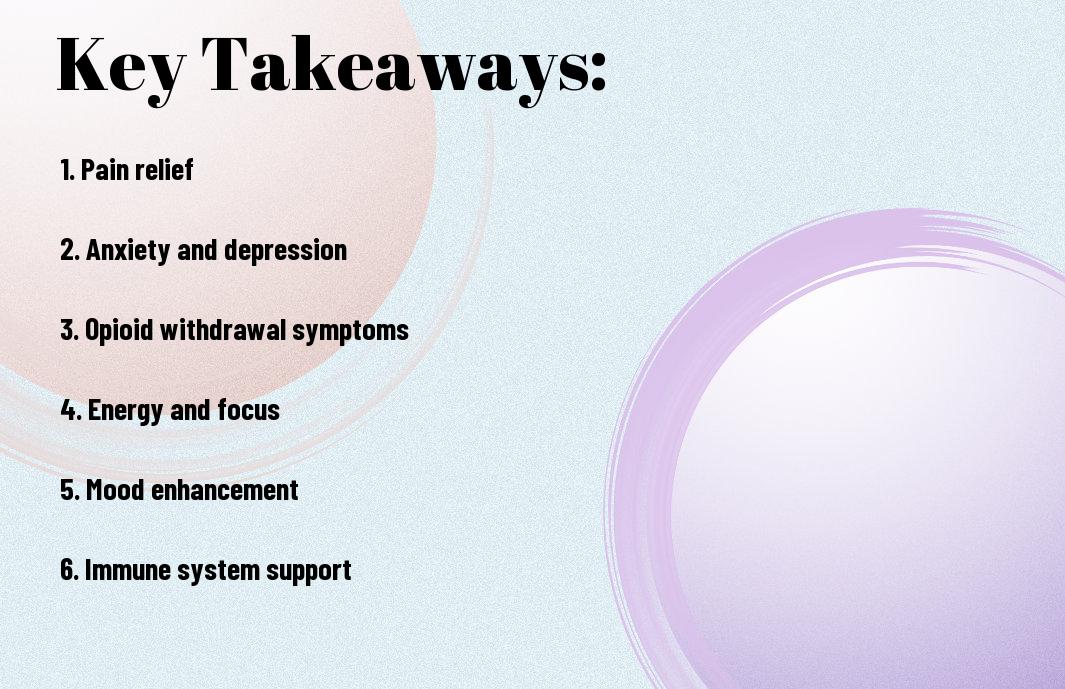Deprecated: mb_convert_encoding(): Handling HTML entities via mbstring is deprecated; use htmlspecialchars, htmlentities, or mb_encode_numericentity/mb_decode_numericentity instead in /home/users/kratomfiles/www/kratomfiles.com/wp-content/plugins/quick-adsense-reloaded/includes/template-functions.php on line 3552
Just like any other natural substance, kratom has both beneficial and potentially harmful effects when used medicinally. This article investigates into the medical applications of kratom, shedding light on its pain-relieving, mood-enhancing, and energy-boosting properties. Understanding the science behind kratom’s effects is imperative in making informed decisions about its medical use.
Key Takeaways:
- Chronic Pain Management: Kratom is often used as an alternative treatment for chronic pain, especially in conditions like arthritis or fibromyalgia.
- Depression and Anxiety: Some people use kratom to alleviate symptoms of depression and anxiety, as it may have mood-boosting effects.
- Opioid Withdrawal: Kratom has been explored as a possible aid for managing opioid withdrawal symptoms, due to its interactions with opioid receptors in the brain.

Historical Background of Kratom
While kratom is gaining popularity in Western countries for its potential medical benefits, its traditional use dates back centuries in Southeast Asia.
Traditional Use in Southeast Asia
The indigenous people of Southeast Asia have been using kratom as a traditional medicine for various ailments such as pain relief, energy enhancement, and mood elevation. Kratom leaves were commonly chewed or brewed into a tea for their stimulating and pain-relieving effects. In countries like Thailand, Malaysia, and Indonesia, kratom was also used during labor-intensive work to combat fatigue and improve productivity.
Early Western Interest and Research
Background: Early Western explorers and researchers were intrigued by kratom’s potential medicinal properties after encountering its traditional use in Southeast Asia. In the 19th century, kratom was introduced to the Western world, and researchers began studying its pharmacological effects. However, due to limited technology and knowledge at the time, research on kratom was scarce and inconclusive.
With modern advancements in science, researchers are now gaining a better understanding of kratom’s alkaloids and their potential effects on the body. Recent studies have shown promise in using kratom for pain management, opioid withdrawal symptoms, and mood disorders.
Pharmacological Profile of Kratom
Now, Kratom: What Are The Health Benefits vs. Risks?
Active Alkaloids and Their Effects
The active alkaloids in Kratom, such as mitragynine and 7-hydroxymitragynine, interact with opioid receptors in the brain, producing effects that are similar to but milder than opioids. These alkaloids can result in analgesic, stimulant, and mood-enhancing effects for users.
Comparison to Opioids and Stimulants
With relatively lower respiratory depression compared to opioids, Kratom poses a potentially lower risk of overdose. However, its addictive potential and withdrawal symptoms are similar to opioids. It also exhibits stimulant-like effects, making it a popular choice for individuals seeking increased energy and focus.
With a closer look at the comparison to opioids and stimulants:
| Opioids | Kratom |
| High risk of respiratory depression | Lower risk of respiratory depression |
| High risk of overdose | Lower risk of overdose |
| Highly addictive | Similar addictive potential |
| Strong withdrawal symptoms | Similar withdrawal symptoms |
Kratom provides a complex pharmacological profile that offers both promising health benefits and potential risks, making its medical usage a subject of much debate and ongoing research.

Pain Relief and Management
For centuries, kratom has been used as a natural pain reliever by various cultures. Its active alkaloids, such as mitragynine and 7-hydroxymitragynine, interact with the opioid receptors in the brain, which are responsible for regulating pain perception, thus providing analgesic effects.
Mechanisms of Analgesia
Pain relief from kratom occurs when the alkaloids bind to the mu-opioid receptors in the brain. This interaction triggers the release of neurotransmitters like endorphins, which are the body’s natural painkillers. Kratom also acts on the delta and kappa opioid receptors, further enhancing its analgesic properties. These mechanisms work together to alleviate pain and promote feelings of well-being.
Clinical Trials and Studies
An increasing number of clinical trials and studies are being conducted to evaluate kratom’s efficacy in managing pain. While some research shows promising results in using kratom for pain relief, there is currently limited scientific evidence to support its widespread use as an analgesic. Further research is needed to determine the safety, effectiveness, and potential risks associated with its long-term use.
Despite the lack of conclusive evidence, many individuals report experiencing pain relief and improved quality of life with the use of kratom. It is crucial for healthcare providers and consumers to approach kratom use for pain management with caution and to consult with medical professionals before incorporating it into their treatment regimen.
Opioid Withdrawal and Addiction Treatment
Unlike Drug Fact Sheet: Kratom is a natural herbal supplement that has gained attention for its potential to help individuals struggling with opioid withdrawal and addiction. Some researchers and users have suggested that kratom could be a safer alternative to traditional opioids due to its milder effects on the respiratory system.
Kratom as a Potential Alternative
Opioid addiction is a serious and challenging condition that affects many individuals worldwide. Kratom has been considered by some as a potential alternative treatment for opioid withdrawal and addiction due to its opioid-like effects. However, it’s important to note that while some studies suggest kratom may help manage withdrawal symptoms, more research is needed to fully understand its effectiveness and safety.
Success Stories and Anecdotal Evidence
To date, there have been numerous anecdotal reports and success stories from individuals who claim that kratom has helped them manage their opioid addiction and withdrawal symptoms. Many users believe that kratom has played a crucial role in their journey to sobriety and improved quality of life. However, it’s crucial to approach these stories with caution and remember that individual experiences may vary.
Plus, while some individuals have reported positive outcomes with kratom use for opioid addiction, there are also potential risks and dangers associated with its consumption. It’s imperative to consult with a healthcare professional before considering kratom as a treatment option and to be aware of the potential for addiction and other adverse effects.
Based on the available evidence, it’s clear that more research is needed to determine the safety and efficacy of kratom for opioid withdrawal and addiction treatment. As with any medical treatment, it’s crucial to approach kratom with caution and under the guidance of a healthcare provider.
Anxiety and Mood Disorders
Once again, kratom has shown promising effects in managing anxiety and mood disorders.
Anxiolytic and Antidepressant Properties
With its ability to interact with opioid receptors in the brain, kratom exhibits anxiolytic and antidepressant properties. This natural substance can help alleviate symptoms of anxiety and depression, providing relief for individuals struggling with these conditions.
User Reports and Online Forums
Anxiolytic reports from users on online forums and platforms indicate that kratom can effectively reduce feelings of anxiousness and induce a sense of calmness. Many users have shared their positive experiences using kratom to manage anxiety and mood swings.
To investigate deeper into the effects of kratom on anxiety and mood disorders, it is crucial to consult medical professionals and conduct thorough research to ensure safe and responsible usage.It is important to note that kratom should be used cautiously and in moderation to avoid dependency and adverse effects.
Other Medical Applications
Inflammation and Immune System Modulation
Keep in mind that kratom has potential benefits for inflammation and immune system regulation. Some studies suggest that the alkaloids found in kratom may have anti-inflammatory properties that could help with conditions such as arthritis and other inflammatory diseases. Additionally, kratom may also modulate the immune system response, which could have implications for autoimmune disorders.
Antimicrobial and Antiviral Properties
With regard to antimicrobial and antiviral properties, kratom has shown some promising results in lab studies. Some research suggests that certain compounds in kratom may have antimicrobial effects against different pathogens, which could be beneficial for combating infections. Additionally, antiviral properties have been observed in kratom extracts, showing potential for helping in the fight against viral infections.
Other medical applications of kratom are still being researched extensively, and more studies are needed to fully understand the extent of its benefits. While these preliminary findings are promising, it is important to approach kratom as a complementary therapy and consult with a healthcare professional before incorporating it into a treatment plan.
Is Kratom’s Traditional Use Linked to Its Medical Benefits?
There is growing interest in understanding the potential medical benefits of kratom traditional medicinal uses. Many believe that its traditional use for pain relief and energy boost may be linked to its therapeutic properties. Research into this natural herb’s potential is ongoing, shedding light on its ancient healing properties.
Are There Other Medical Benefits of Kratom Besides Pain Relief?
Yes, there are various uses of kratom beyond pain relief. Some studies suggest that it may have potential benefits for managing anxiety, depression, opioid withdrawal symptoms, and improving overall mood. However, more research is needed to fully understand the extent of its medical benefits.
How Can Kratom Products be Used for Medical Purposes?
Kratom product uses and benefits have been studied for their potential medical purposes. Some research suggests that kratom may have analgesic and mood-boosting effects, making it a potential alternative to traditional pain medications and antidepressants. However, more research is needed to fully understand its efficacy and safety for medical use.
Safety Concerns and Potential Risks
Many individuals who use kratom may experience side effects such as nausea, constipation, and dizziness. In more severe cases, kratom can lead to respiratory depression, seizures, and liver damage. It’s important to note that kratom can also interact with other medications, potentially causing harmful reactions. Individuals with pre-existing health conditions or those taking prescription medications should exercise caution when using kratom.
Side Effects and Interactions
Concerns about the safety of kratom also extend to its potential interactions with other substances. Kratom has been known to react with drugs like antidepressants and opioid painkillers, leading to adverse effects. Additionally, the lack of regulation and consistency in kratom products can make it challenging to determine proper dosages and avoid unwanted interactions. It is crucial for individuals considering kratom use to consult with a healthcare professional to minimize risks.
Regulatory Status and Controversies
Effects surrounding kratom’s regulatory status and controversies have been a topic of debate in the medical and legislative fields. The regulatory status of kratom varies across countries and states, with some banning its sale due to safety concerns and the potential for abuse. However, proponents argue that kratom holds promise for managing pain and opioid withdrawal symptoms, leading to ongoing controversies about its legal status.
It is imperative for individuals to be aware of the potential risks and controversies surrounding kratom use, ensuring that they make informed decisions about its medical applications.
Final Words
Following this insightful exploration of the medical uses of Kratom, it is evident that this plant has the potential to offer various therapeutic benefits for individuals struggling with pain, anxiety, and opioid addiction. While more research is needed to fully understand its mechanisms and potential side effects, Kratom shows promise as a natural alternative for managing certain medical conditions.
FAQ
Q: What is Kratom?
A: Kratom is a tropical tree native to Southeast Asia, known scientifically as Mitragyna speciosa. It is commonly used for its medicinal properties and recreational effects.
Q: What is Kratom used for medically?
A: Kratom is used medically for pain relief, management of opioid withdrawal symptoms, anxiety, depression, and as a stimulant to boost energy and focus.
Q: How is Kratom consumed for medical purposes?
A: Kratom leaves can be chewed, brewed into a tea, smoked, or ingested in capsules. The method of consumption can impact the onset of effects and their duration.
Q: Is Kratom legal and regulated for medical use?
A: The legal status of Kratom varies by country and state. In some places, Kratom is regulated as a controlled substance, while in others it is legally available for purchase without restrictions.
Q: What are the potential risks and side effects of using Kratom for medical purposes?
A: Some potential risks of Kratom use include dependence, addiction, withdrawal symptoms, and adverse effects on mental health. It is important to use Kratom responsibly and under medical supervision.








